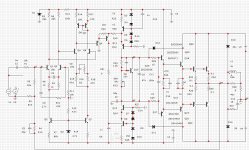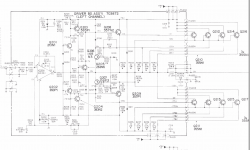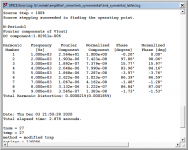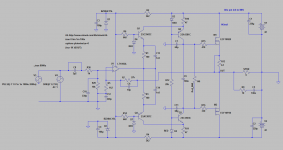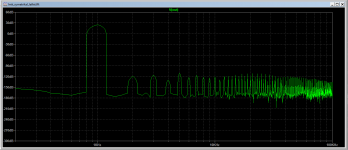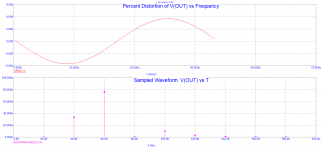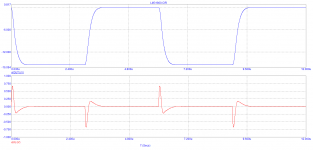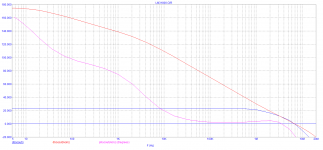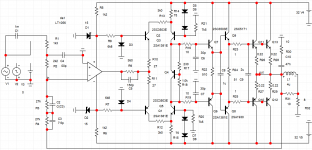This is not Otala..
Slightly simplier and better.
I don't remember which is better
Attachments
Last edited:
Looks good. More or less equal to the latest 'discrete' version of LMK/Wiederhold amp, but faster.
Since I already built few of these, I would rather try something new, unless it's new LMK/Wiedehold style amp is much improved than these that I already built.
4 stage topology (not exactly Otala!) is something new I never tried, so maybe it's time...
But I'm going to spend more time on simulating it and trying different things with it first.
Another option I'm considering researching is this CFA Marantz offspring:
Apex A40 fundamental improvement. (Sandy)
Totally different animal.
Since I already built few of these, I would rather try something new, unless it's new LMK/Wiedehold style amp is much improved than these that I already built.
4 stage topology (not exactly Otala!) is something new I never tried, so maybe it's time...
But I'm going to spend more time on simulating it and trying different things with it first.
Another option I'm considering researching is this CFA Marantz offspring:
Apex A40 fundamental improvement. (Sandy)
Totally different animal.
Last edited:
I would really prefer op-amp version too. But I had bad experience with fast op-amps, especially those that need extra compensation.
I built several amps with op-amps, and in most of them I could not even stop LT1056 from oscillating... (not much oscillating, but it's not acceptable).
I would prefer to use TLE2071, TLE 2081 which are around 50V/us fast, but
the final amp is still 15V/us. I don't know how to resolve this issue.
Each stage separately should be fast enough (op-amp, VAS, output), but put together that are still at 15V/us...
Or - if the amp is faster, than square waves won't behave properly... and fix them, you need to make it slower..
I built several amps with op-amps, and in most of them I could not even stop LT1056 from oscillating... (not much oscillating, but it's not acceptable).
I would prefer to use TLE2071, TLE 2081 which are around 50V/us fast, but
the final amp is still 15V/us. I don't know how to resolve this issue.
Each stage separately should be fast enough (op-amp, VAS, output), but put together that are still at 15V/us...
Or - if the amp is faster, than square waves won't behave properly... and fix them, you need to make it slower..
It all depends on the Board technology. We need to change the approach to PCB designWe are only looking at amplifiers with a large loop gain, and they are capricious to install
I would prefer to use TLE2071, TLE 2081 which are around 50V/us fast, but
tSimplified monster can try ? On opamphe final amp is still 15V/us. I don't know how to resolve this issue.
Last edited:
First we need to come up with an amp (e.g. version of LMK/Wiederhold), with faster op-amp (E.g. TLE2081), that at least would sim well, had SR > 40V/us, nice frequency profile to your liking, and had good square waves, clip, and was relatively simple 🙂
That's all 🙂
That's all 🙂
Parasitic capacitance of installation it is necessary to reduce
Well, here's a quick booster .Clone of my monster
Well, here's a quick booster .Clone of my monster
Attachments
Last edited:
How many amps you have simmed?
Must be very impressive number 🙂
I normally don't have time for this, but now I'm working from home, and end of year is a slow period
for us...
Must be very impressive number 🙂
I normally don't have time for this, but now I'm working from home, and end of year is a slow period
for us...
The end of the year is the end of the year!.While you're working!
well, I'm retired.And the schemes, just when mastering MS-9, are by-products. I just learned how to model and draw a printed circuit Board, as well as how to solder in a modern way.
монстрик 200вт 4 ом.
well, I'm retired.And the schemes, just when mastering MS-9, are by-products. I just learned how to model and draw a printed circuit Board, as well as how to solder in a modern way.
монстрик 200вт 4 ом.
Philips 22AH578
op-amp has SlewRate 15V/us yet whole amp is almost 60V/us
and relatively simple. Low distortions, very nice square waves.
Originally rails were at 78V, so perhaps SlewRate can be even higher..
op-amp has SlewRate 15V/us yet whole amp is almost 60V/us
and relatively simple. Low distortions, very nice square waves.
Originally rails were at 78V, so perhaps SlewRate can be even higher..
Attachments
Symmetrical Wiederhold amp
It seems that secret to higher slew rate in this topology (LMK/Wiederhold) is in symmetry.
I see that symmetrical LMK (or is Wiederhold?) is able to do over 50V/us with all other parameters not worse than before.
Here is an example. Square waves have rise time ~1us for 50V swing.
That's even with relatively slow op-amp (LT1056).
With asymmetrical design, it was impossible (for me) to get good square waves handling, and speed, at the same time.
For some strange reason, this symmetrical designs reminds me of Blomley/Hartsuiker design..
It seems that secret to higher slew rate in this topology (LMK/Wiederhold) is in symmetry.
I see that symmetrical LMK (or is Wiederhold?) is able to do over 50V/us with all other parameters not worse than before.
Here is an example. Square waves have rise time ~1us for 50V swing.
That's even with relatively slow op-amp (LT1056).
With asymmetrical design, it was impossible (for me) to get good square waves handling, and speed, at the same time.
For some strange reason, this symmetrical designs reminds me of Blomley/Hartsuiker design..
Attachments
Last edited:
>And why do you look at distortion at 1kHz, and not at 20kHz
1kHz is a start.... Work in progress.
1kHz is a start.... Work in progress.
What you are simulating in last post, is not the same as mine.
When I tested your symmetrical designs from few weeks ago, I agree - they did not surpass LMK. That's why I didn't continued with them.
But I tried slightly different design yesterday.
Schematic I published yesterday night, simulates the same as LMK, at least for me. I don't see any problems with it. All the numbers/graphs are very close to LMK/Wiederhold.
When I tested your symmetrical designs from few weeks ago, I agree - they did not surpass LMK. That's why I didn't continued with them.
But I tried slightly different design yesterday.
Schematic I published yesterday night, simulates the same as LMK, at least for me. I don't see any problems with it. All the numbers/graphs are very close to LMK/Wiederhold.
What is R2 in your schematic? connected between (+) and (-) of op-amp?
Also, if you want to test symmetrical schemas - do not use inverted input with (-) grounded.
This approach is messing up square waves.
Non-inverting approach gives much better results - at least for square waves and speed. I compared them.
Also, if you want to test symmetrical schemas - do not use inverted input with (-) grounded.
This approach is messing up square waves.
Non-inverting approach gives much better results - at least for square waves and speed. I compared them.
The only difference is in the inverting switching on of the op-amp . .Well, Bipolars in VK instead of laterals
- Home
- Amplifiers
- Solid State
- Unusual amp from 1987

